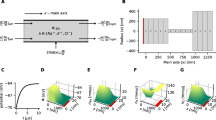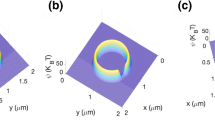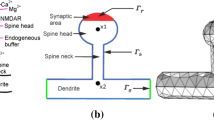Abstract
The biophysical properties of dendritic spines play a critical role in neuronal integration but are still poorly understood, due to experimental difficulties in accessing them. Spine biophysics has been traditionally explored using theoretical models based on cable theory. However, cable theory generally assumes that concentration changes associated with ionic currents are negligible and, therefore, ignores electrodiffusion, i.e. the interaction between electric fields and ionic diffusion. This assumption, while true for large neuronal compartments, could be incorrect when applied to femto-liter size structures such as dendritic spines. To extend cable theory and explore electrodiffusion effects, we use here the Poisson (P) and Nernst-Planck (NP) equations, which relate electric field to charge and Fick’s law of diffusion, to model ion concentration dynamics in spines receiving excitatory synaptic potentials (EPSPs). We use experimentally measured voltage transients from spines with nanoelectrodes to explore these dynamics with realistic parameters. We find that (i) passive diffusion and electrodiffusion jointly affect the dynamics of spine EPSPs; (ii) spine geometry plays a key role in shaping EPSPs; and, (iii) the spine-neck resistance dynamically decreases during EPSPs, leading to short-term synaptic facilitation. Our formulation, which complements and extends cable theory, can be easily adapted to model ionic biophysics in other nanoscale bio-compartments.






Similar content being viewed by others
References
Harris, K. M., & Kater, S. (1994). Dendritic spines: Cellular specializations imparting both stability and flexibility to synaptic function. Annual Review of Neuroscience, 17(1), 341–371.
Yuste, R. (2011). Dendritic spines and distributed circuits. Neuron, 71(5), 772–781.
Yuste, R. (2010). Dendritic Spines. Cambridge: MIT Press.
Yuste, R., & Majewska, A. (2001). On the function of dendritic spines. Neuroscientist, 7(5), 387–395.
Yang, G., Pan, F., & Gan, W.-B. (2009). Stably maintained dendritic spines are associated with lifelong memories. Nature, 462(7275), 920–924.
Stuart, G. J., & Spruston, N. (2015). Dendritic integration: 60 years of progress. Nature Neuroscience, 18(12), 1713–1721.
Popovic, M. A., Carnevale, N., Rozsa, B., & Zecevic, D. (2015). Electrical behaviour of dendritic spines as revealed by voltage imaging. Nature Communications, 6, 8436.
Jayant, K., Hirtz, J. J., Plante, I. J. L., Tsai, D. M., de Boer, W. D. A. M., Semonche, A., Peterka, D. S., Owen, J. S., Sahin, O., Shepard, K. L., & Yuste, R. (2017). Targeted intracellular voltage recordings from dendritic spines using quantum-dot-coated nanopipettes. Nature Nanotechnology, 12(4), 335–342.
Grunditz, A., Holbro, N., Tian, L., Zuo, Y., & Oertner, T. G. (2008). Spine neck plasticity controls postsynaptic calcium signals through electrical compartmentalization. The Journal of neuroscience : the official journal of the Society for Neuroscience, 28(50), 13457–13466.
Acker, C. D., Hoyos, E., & Loew, L. M. (2016). EPSPs Measured in Proximal Dendritic Spines of Cortical Pyramidal Neurons. eNeuro, 3(2). https://doi.org/10.1523/ENEURO.0050-15.2016.
Harnett, M. T., Makara, J. K., Spruston, N., Kath, W. L., & Magee, J. C. (2012). Synaptic amplification by dendritic spines enhances input cooperativity. Nature, 491, 599–602.
Cartailler, J., et al.. (2017a). Deconvolution of voltage sensor time series and electro-diffusion modeling of synaptic input in dendritic spines. Neuron, . (in press).
Svoboda, K., Tank, D. W., & Denk, W. (1996). Direct measurement of coupling between dendritic spines and shafts. Science, 272, 716–719.
Tønnesen, J., Katona, G., Rózsa, B., & Nägerl, U. V. (2014). Spine neck plasticity regulates compartmentalization of synapses. Nature Neuroscience, 17(5), 678–685.
Beaulieu-Laroche, L., Harnett, M.T. (2017). Dendritic Spines prevent synaptic voltage clamp. Neuron.
Araya, R., Jiang, J., Eisenthal, K. B., & Yuste, R. (2006). The spine neck filters membrane potentials. Proceedings of the National Academy of Sciences of the United States of America, 103(47), 17961–17966.
Kwon, T., Sakamoto, M., Peterka, D. S., & Yuste, R. (2017). Attenuation of synaptic potentials in dendritic Spines. Cell Reports, 20(5), 1100–1110.
Arellano, J. I., Benavides-Piccione, R., Defelipe, J., & Yuste, R. (2007). Ultrastructure of dendritic spines: Correlation between synaptic and spine morphologies. Frontiers in Neuroscience, 1(1), 131–143.
Segev, I., & Rall, W. (1998). Excitable dendrites and spines: Earlier theoretical insights elucidate recent direct observations. Trends in Neurosciences, 21(11), 453–460.
Koch, C. (1984). Cable theory in neurons with active, linearized membranes. Biological Cybernetics, 50(1), 15–33.
Koch, C., & Poggio, T. (1983). Electrical properties of dendritic spines. TINS, 6, 80–83.
Koch, C., Segev, I. (1998). Methods in neuronal modeling: from ions to networks. MIT press.
Jack, J. J. B., Noble, D., & Tsien, R. W. (1975). Electric current flow in excitable cells. London: Oxford University Press.
Bloodgood, B. L., & Sabatini, B. L. (2005). Neuronal activity regulates diffusion across the neck of dendritic spines. Science, 310, 866–869.
Miyazaki, K., Ross, W. N.. (2017). Sodium dynamics in pyramidal neuron dendritic spines: synaptically evoked entry predominantly through AMPA receptors and removal by diffusion. Journal of Neuroscience, p. 1758–17.
Schuss, Z., Singer, A., & Holcman, D. (2007). The narrow escape problem for diffusion in cellular microdomains. Proceedings of the National Academy of Sciences of the United States of America, 104(41), 16098–16103.
Kushmerick, M., & Podolsky, R. (1969). Ionic mobility in muscle cells. Science, 166(3910), 1297–1298.
Qian, N., & Sejnowski, T. (1989). An electro-diffusion model for computing membrane potentials and ionic concentrations in branching dendrites, spines and axons. Biological Cybernetics, 62(1), 1–15.
Savtchenko, L. P., Poo, M. M., & Rusakov, D. A. (2017). Electrodiffusion phenomena in neuroscience: A neglected companion. Nature Reviews. Neuroscience, 18(10), 598–612.
Sylantyev, S., Savtchenko, L. P., Ermolyuk, Y., Michaluk, P., & Rusakov, D. A. (2013). Spike-driven glutamate electrodiffusion triggers synaptic potentiation via a homer-dependent mGluR-NMDAR link. Neuron, 77(3), 528–541.
Sylantyev, S., Savtchenko, L. P., Niu, Y. P., Ivanov, A. I., Jensen, T. P., Kullmann, D. M., Xiao, M. Y., & Rusakov, D. A. (2008). Electric fields due to synaptic currents sharpen excitatory transmission. Science, 319(5871), 1845–1849.
Schuss, Z., Nadler, B., & Eisenberg, R. S. (2001). Derivation of Poisson and Nernst-Planck equations in a bath and channel from a molecular model. Physical Review E, 64(3), 036116.
Holcman, D., & Yuste, R. (2015). The new nanophysiology: Regulation of ionic flow in neuronal subcompartments. Nature Reviews. Neuroscience, 16(11), 685–692.
Chen, D., Lear, J., & Eisenberg, B. (1997). Permeation through an open channel: Poisson-Nernst-Planck theory of a synthetic ionic channel. Biophysical Journal, 72(1), 97–116.
Halnes, G., Mäki-Marttunen, T., Keller, D., Pettersen, K. H., Andreassen, O. A., & Einevoll, G. T. (2016). Effect of ionic diffusion on extracellular potentials in neural tissue. PLoS Computational Biology, 12(11), e1005193.
Pods, J., Schonke, J., & Bastian, P. (2013). Electrodiffusion models of neurons and extracellular space using the Poisson-Nernst-Planck equations--numerical simulation of the intra- and extracellular potential for an axon model. Biophysical Journal, 105(1), 242–254.
Jayant, K., et al. (2013). Programmable ion-sensitive transistor interfaces. II. Biomolecular sensing and manipulation. Physical Review E, 88(1), 012802.
Jayant, K., et al. (2014). Programmable ion-sensitive transistor interfaces. III. Design considerations, signal generation, and sensitivity enhancement. Physical Review E, 89(5), 052817.
Tsay, D., & Yuste, R. (2004). On the electrical function of dendritic spines. Trends in Neurosciences, 27(2), 77–83.
Tovar, R.K., Westbrook, G. L. (2012). Ligand-Gated Ion Channels, in Cell Physiology Source Book (Fourth Edition).
Kosińska, I., et al. (2008). Rectification in synthetic conical nanopores: A one-dimensional Poisson-Nernst-Planck model. Physical Review E, 77(3), 031131.
Goldman, D. E. (1943). Potential, impedance, and rectification in membranes. The Journal of General Physiology, 27(1), 37–60.
Singer, A., & Norbury, J. (2009). A Poisson–Nernst–Planck model for biological ion channels—An asymptotic analysis in a three-dimensional narrow funnel. SIAM Journal on Applied Mathematics, 70(3), 949–968.
Schoch, R. B., Han, J., & Renaud, P. (2008). Transport phenomena in nanofluidics. Reviews of Modern Physics, 80(3), 839–883.
Yuste, R. (2013). Electrical compartmentalization in dendritic spines. Annual Review of Neuroscience, 36, 429–449.
Bourne, J. N., & Harris, K. M. (2008). Balancing structure and function at hippocampal dendritic Spines. Annual Review of Neuroscience, 31, 37–67.
Ngo-Anh, T., et al. (2005). SK channels and NMDA receptors form a ca(2+)-mediated feedback loop in dendritic spines. Nature Neuroscience, 8, 642–649.
Delpire, E., & Staley, K. J. (2014). Novel determinants of the neuronal cl(−) concentration. The Journal of Physiology, 592(19), 4099–4114.
Cartailler, J., Schuss, Z., & Holcman, D. (2017b). Electrostatics of non-neutral biological microdomains. Scientific Reports, 7(1), 11269.
Cartailler, J., Schuss, Z., & Holcman, D. (2017c). Analysis of the Poisson–Nernst–Planck equation in a ball for modeling the voltage–current relation in neurobiological microdomains. Physica D: Nonlinear Phenomena, 339, 39–48.
Zhou, T., Ming, Y., Perry, S. F., & Tatic-Lucic, S. (2016). Estimation of the physical properties of neurons and glial cells using dielectrophoresis crossover frequency. Journal of Biological Physics, 42(4), 571–586.
Acknowledgements
This work was supported by the NIMH (R01MH101218, R01MH100561) and the NINDS (R01NS110422). This material is also based upon work supported by, or in part by, the U. S. Army Research Laboratory and the U. S. Army Research Office under contract number W911NF-12-1-0594 (MURI). T.L. was partly supported by the Fondation pour la Recherche Médicale and the Philippe foundation. K.J was supported by the Kavli Institute of Brain Science at Columbia.
Author information
Authors and Affiliations
Contributions
T.L. and R.Y. conceived the project. T.L performed the modeling and analysis. K.J assisted with model development and analysis. T.L and K.J wrote the manuscript. R.Y assembled and directed the team, provided guidance, funding, and edited the manuscript.
Corresponding author
Ethics declarations
Conflict of interests
The authors declare that they have no conflict of interest.
Additional information
Action Editor: Upinder Singh Bhalla
Publisher’s note
Springer Nature remains neutral with regard to jurisdictional claims in published maps and institutional affiliations.
Electronic supplementary material
SI includes detailed mathematical derivations of the equations presented here in this manuscript.
ESM 1
(PDF 940 kb)
Rights and permissions
About this article
Cite this article
Lagache, T., Jayant, K. & Yuste, R. Electrodiffusion models of synaptic potentials in dendritic spines. J Comput Neurosci 47, 77–89 (2019). https://doi.org/10.1007/s10827-019-00725-5
Received:
Revised:
Accepted:
Published:
Issue Date:
DOI: https://doi.org/10.1007/s10827-019-00725-5




